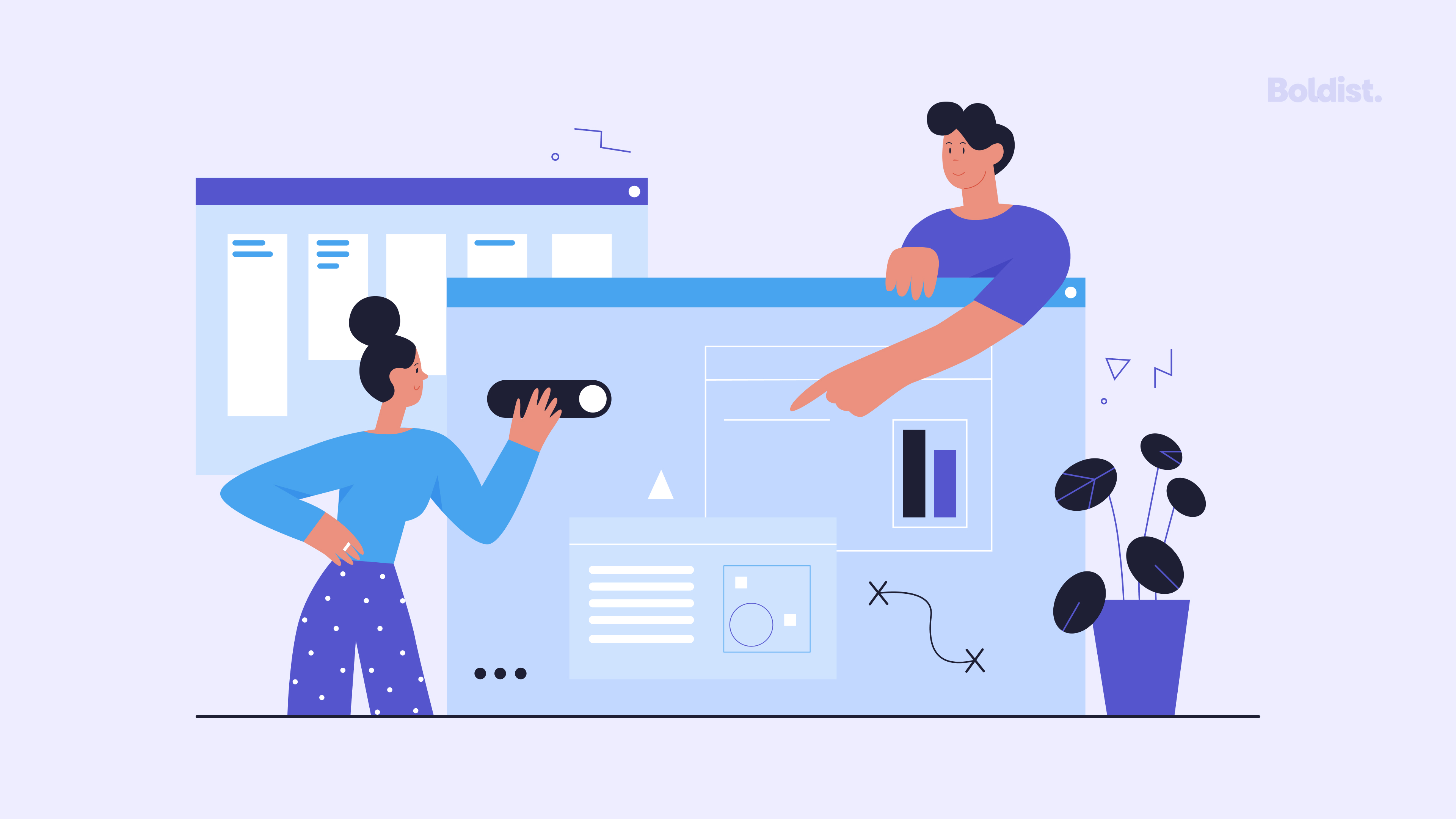Whether you have a career in or related to UX/UI (think tech, marketing, design, development) or run a business, you probably know a thing or two about measuring success. At the very least, you may have a clue about key performance indicators (KPIs): metrics that monitor performance over time.
Today we’re talking about metrics for measuring usability – one of the key elements of effective UX/UI.
Usability is vital whether your application is a tool that you offer clients or a means for selling products. All too often, when tracking metrics, conversion rates steal the show.
But usability ties directly into your ability to convert users in the way you want. After all, they have to effortlessly navigate your website, software, or application to convert.
And when it comes to user experience, you can detect 85% of issues through usability testing.
Before you can conduct a usability test on your product or service, though, you need to know how to measure crucial usability metrics.
Why Measuring Usability Matters
Poor usability is a sign that you need to update your website content. A site can be beautifully designed but have ineffective usability. While adhering to the latest design trends is an added bonus for users, they will still end up leaving your website frustrated if they can’t find the information they need. And chances are that those frustrated users will turn to your competitors instead.
Better usability equals a better user experience. A better user experience means that users are more likely to return and become loyal customers, boosting their long term value. People are also willing to pay more for a quality experience.
Conducting usability tests with focus groups will provide insight into your product’s unique positioning and advantage in the mind of the user.
Measuring the usability of a product will tell you if you’re providing a sufficient user experience, what changes you need to make, and allow you to track usability improvements over time.
Defining Usability and Goals
The Interactive Design Foundation defines usability as:
“…a measure of how well a specific user in a specific context can use a product/design to achieve a defined goal effectively, efficiently and satisfactorily.”
As this definition indicates, there are three goals that a usability framework takes into consideration:
- Effectiveness: How accurately and thoroughly it helps the user complete the task.
- Efficiency: How much effort the user has to put in to complete the task.
- Satisfaction: How the user feels about their experience using your product.
You must also factor in that different people want different things and have their preferences. So the usability of a product will depend on who is using it or who your target audience is. For this reason, conducting user research is crucial to understanding your ideal user’s pain points, demographics, and goals.
With this information, you can create personas to guide you in developing and enhancing your product’s usability.
You can test usability metrics on beginner and expert users. Testing beginners’ experiences prove valuable in finding barriers that turn into bounce rates, whereas studying the behaviors of your most loyal expert users can push your usability the extra mile.
The Most Important Usability Metrics
Improving usability is one way to reduce churn rates and boost conversions, but you can’t improve it without knowing how to measure it first. Read on to learn about essential usability metrics and how they work.
Completion Rates: An Effectiveness Metric
Completion rate is one of the most critical effectiveness metrics, but it’s also one of the most straightforward and easy to collect. Completion rates are about the end result and measure how many people successfully complete a task. While task success is always significant, this is especially the case when failure to complete a task harms the user experience.
To measure the completion rate, decide on the task you want to track and what counts as passing criteria. It may look like submitting a form, finding a piece of information, or making a purchase.
When assessing websites and apps, you can use clicks and impressions to see if a user takes the right path to completion.
While this metric should be continuously evaluated, make sure to test it in the wireframe development phase.
User Errors Made: An Effectiveness Metric
User error is a metric that tracks the mistakes a user makes while attempting to complete a task. Too many user errors indicate that there’s a problem you should address. Despite the name, user errors are the responsibility of designers. A good UX/UI designer does their best to predict problem areas and prevent them.
Keeping user error in mind saves time and money. Studies show that fixing problems in development is 10 times more expensive than fixing them in the design phase.
You can get ahead by testing user errors in advance. Record when and where they occur to diagnose problem areas. We also suggest categorizing errors by type and severity so prioritizing errors is easier on your team.
Types of user errors to look out for include:
- Unintended actions
- Picking the wrong links
- Omissions
- Inserting the wrong information
- Misinterpreting content
- Missing the intended target
- Inaccurate sense of task completion
Usability Problems: An Effectiveness Metric
Usability problems are friction areas that make it harder for users to complete tasks, but they occur on the application’s end instead of the user’s. Examples include slow loading speed or unclear error messages. These problems can be local or global, affecting a small portion of the interface or the whole thing.
Like user errors, when you track usability problems, you should categorize and rank them for severity. A severity ranking scale may look like this:
- Mere suggestions
- Minimally affects task success
- Causes delay or frustration
- Prevents task completion
Task Times: An Efficiency Metric
Task times, or the time it takes a user to complete a task, is a core usability metric for efficiency. If the time spent on a task is longer than it should be, it’s an indicator that you should redesign your interface.
Task times are important to track because we live in an era of impatience. Users want answers and solutions stat, and you need to provide them. Too much time spent on a task is also a sign of effort on the user’s end. Usability makes for happier users by streamlining the process and making everything quick and easy to access.
Measure task times by tracking how long focus group members take to complete a task on average or measure the time spent on a page before task completion. Measure the time spent on a task in seconds or minutes.
You can also determine your website’s or application’s overall relative efficiency by calculating the ratio of time spent by successful users and time spent by all users (including those who didn’t complete the task).
Task Level Satisfaction: A Satisfaction Metric
By reaching out to users after they attempt to complete a task with your product, you can measure their task level satisfaction – one of two satisfaction metrics. This metric measures a user’s level of satisfaction with your product, giving direct feedback on product usability.
You measure task level satisfaction by asking users to rate their experience once they end a session. A common choice is to ask them to choose between very dissatisfied, dissatisfied, neutral, satisfied, and very satisfied. You can also give the option to leave a comment.
Getting a user’s emotional response right after completing the task in question can help enhance your design.
Test Level Satisfaction: A Satisfaction Metric
Test level satisfaction is the other of the two satisfaction metrics. It’s similar to task level satisfaction, but you measure it in a usability test environment where participants share their satisfaction ratings. This kind of user testing is better at testing the overall ease of using your product over completing a single task.
Take Advantage of A/B Testing
Now that you know the main usability metrics to track, you should make sure to take advantage of A/B testing for design enhancement. While A/B testing is often used in marketing for testing campaign strategies, it’s just as beneficial when designing for usability.
Whether you’re developing a new product from scratch or redesigning one you own, A/B testing allows you to test two iterations at the same time. By comparing the usability metrics discussed, you can determine which design iteration works best.
Make sure when conducting an A/B usability test that you only test one change at a time to ensure that the results you get result from that change.
Summarize and Document Results
Anytime you conduct a usability test, you should document and summarize the results. To effectively track usability, you should have a defined process in place for collecting, analyzing, and reporting insights from your metrics. This is how you’ll keep track of successes and failures, prevent repeat mistakes, and monitor progress over time.
Having a process for collecting and documenting your metrics will also improve your knowledge and experience of what designs work best in particular contexts.
Test Usability on the Regular
Improving your website’s or application’s usability is a process, and there’s always room for growth. On top of that, user expectations continue to reach new heights as industries advance. It’s why measuring usability is ongoing. You should check your usability metrics routinely, and any time you make a change. It’s how you’ll reap benefits like increased conversion rates.
If you have a digital product that you need developed or redesigned with usability in mind, reach out to the experts.


